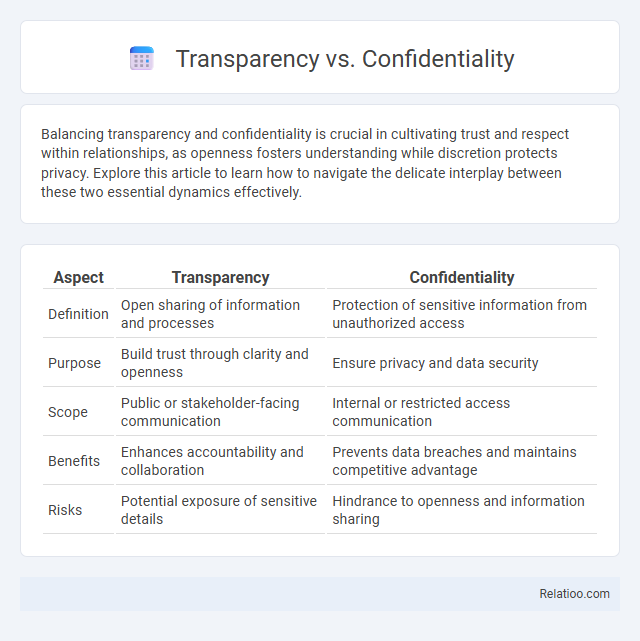Balancing transparency and confidentiality is crucial in cultivating trust and respect within relationships, as openness fosters understanding while discretion protects privacy. Explore this article to learn how to navigate the delicate interplay between these two essential dynamics effectively.
Table of Comparison
| Aspect | Transparency | Confidentiality |
|---|---|---|
| Definition | Open sharing of information and processes | Protection of sensitive information from unauthorized access |
| Purpose | Build trust through clarity and openness | Ensure privacy and data security |
| Scope | Public or stakeholder-facing communication | Internal or restricted access communication |
| Benefits | Enhances accountability and collaboration | Prevents data breaches and maintains competitive advantage |
| Risks | Potential exposure of sensitive details | Hindrance to openness and information sharing |
Understanding Transparency and Confidentiality
Understanding transparency involves openly sharing relevant information to foster clarity and accountability, while confidentiality emphasizes protecting sensitive data to maintain privacy and security. Balancing transparency and confidentiality requires selective disclosure that respects privacy without undermining openness. This equilibrium is essential for trust-building, as stakeholders value honesty paired with safeguarding critical information.
Key Differences Between Transparency and Confidentiality
Transparency involves openly sharing information to foster accountability and trust, whereas confidentiality restricts information access to protect sensitive data and privacy. Key differences include transparency's emphasis on openness and public disclosure, while confidentiality prioritizes discretion and controlled information flow. Trust-building balances both by ensuring transparency does not compromise confidential information, maintaining credibility and secure relationships.
The Importance of Transparency in Modern Organizations
Transparency in modern organizations fosters openness and accountability, essential for building trust with employees, customers, and stakeholders. Your commitment to clear communication and information sharing enhances collaboration and reduces uncertainties, promoting a positive workplace culture. Balancing transparency with confidentiality ensures sensitive data is protected while maintaining integrity and trust-building efforts.
The Role of Confidentiality in Protecting Sensitive Information
Confidentiality plays a crucial role in protecting sensitive information by ensuring that personal or proprietary data remains secure from unauthorized access. Maintaining confidentiality not only complies with legal and ethical standards but also fosters trust between individuals and organizations by demonstrating a commitment to safeguarding privacy. Your ability to balance transparency with confidentiality directly impacts trust-building and the preservation of critical information in professional relationships.
Balancing Transparency and Confidentiality: Challenges and Strategies
Balancing transparency and confidentiality requires navigating complex challenges such as protecting sensitive information while fostering open communication to build trust within your organization. Strategies include implementing clear policies on data sharing, using role-based access controls, and regularly training employees on the importance of confidentiality and transparency. Maintaining this balance enhances trust-building by ensuring stakeholders feel informed without compromising critical privacy or security standards.
Legal and Ethical Considerations
Legal frameworks such as GDPR and HIPAA mandate transparency in data handling while enforcing confidentiality to protect sensitive information and uphold individuals' privacy rights. Ethical considerations require organizations to balance disclosing necessary information with safeguarding confidential data to foster trust-building among stakeholders. Trust is strengthened when legal compliance aligns with ethical transparency, ensuring accountability and respect for client and employee privacy.
Real-World Examples: Successes and Failures
Transparency in companies like Buffer, known for open salary policies, fosters trust and employee satisfaction, while excessive transparency in contexts like product development leaks at Tesla has sometimes undermined competitive advantage. Confidentiality in healthcare organizations, exemplified by HIPAA compliance, protects patient information but can hinder communication if overly restrictive, as seen in certain hospital data-sharing failures. Trust-building through balanced transparency and confidentiality is evident in firms like Patagonia, where selective disclosure of supply chain details enhances brand loyalty while safeguarding proprietary information.
Impact on Stakeholder Trust and Engagement
Balancing transparency with confidentiality is crucial in building stakeholder trust and fostering meaningful engagement, as transparent communication promotes openness while safeguarding sensitive information upholds privacy and security. Organizations that effectively manage this balance create environments where stakeholders feel informed and respected, enhancing credibility and long-term loyalty. Clear policies on data protection and open dialogue about decision-making processes directly influence stakeholders' perception of integrity and commitment.
Best Practices for Managing Transparency and Confidentiality
Effective management of transparency and confidentiality requires clearly defining information categories and access levels within an organization's data governance framework. Implementing robust encryption and role-based access control systems ensures sensitive information remains confidential while allowing transparent communication where appropriate. Establishing regular training and audit protocols fosters trust-building by demonstrating consistent commitment to ethical information handling and accountability.
Future Trends in Transparency and Confidentiality
Future trends in transparency emphasize enhanced data-sharing technologies that balance openness with stringent privacy controls, leveraging blockchain and AI for accountable information flow. Confidentiality protocols are evolving with advanced encryption methods and decentralized identity systems to protect sensitive data while enabling selective disclosure. Trust-building increasingly depends on transparent governance frameworks and real-time auditability, fostering stronger stakeholder confidence in digital environments.

Infographic: Transparency vs Confidentiality
 relatioo.com
relatioo.com